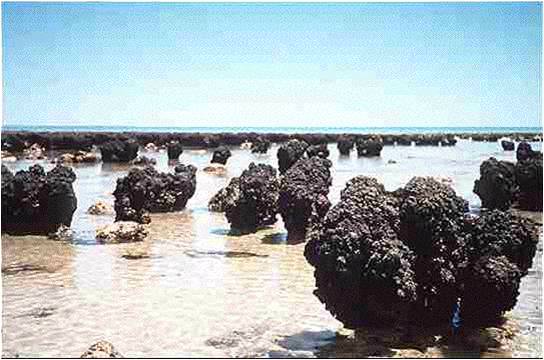 We
have summarized some of the major epochs in the history of the Earth before,
but we will review them here and add in important evolutionary events in the
history of life.
We
have summarized some of the major epochs in the history of the Earth before,
but we will review them here and add in important evolutionary events in the
history of life.
The use of fossils and genetic phylogenies have allowed scientists to reconstruct the history of life and the major epochs and innovations of evolution that have occurred over the last 4 billion years of earth's history. Perhaps the most surprizing thing that we have learned is that we humans are very late arrivals on the evolutionary stage, and that the play had been going on just fine for quite a long while without us. Indeed, the evolution of anything you might recognize as an 'animal' is a fairly recent event in the evolutionary history of the planet; animals have only been present for the last 1/7th of earth history. Although we might think of macroscopic animals and plants as the 'most important' forms of life somehow, it is really the little things - bacteria and archaeans - that keep the biosphere running and allow animals and plants to survive. Without bacteria, you would not digest your food efficiently, plants would have a more difficult time absorbing nutrients, and the nutrients in dead organisms would not be recycled and made available to those of us that are still alive. The basic life processes that drive the biosphere - things like nitrogen fixation, photosynthesis, respiration and energy conversion, and decomposition - are still driven by bacteria. In the first part of this lecture, we'll see that is, indeed, how it has been for the majority of earth history.
 We
have summarized some of the major epochs in the history of the Earth before,
but we will review them here and add in important evolutionary events in the
history of life.
We
have summarized some of the major epochs in the history of the Earth before,
but we will review them here and add in important evolutionary events in the
history of life.
4.5 billion years ago - Earth formed (Evidence: meteorites and moon rocks date to this age, dating the condensation of planetissimals in the solar system)
4.0 bya - oldest rocks (The oldest rocks are not as old as the Earth because the Earth's surface was molten - as a result of constant meteorite bombardment and the energy released during the stratification of Earth's core, mantle, and crust. In addition, the Earth is tectonically active, recycling its crust. So, older rocks that may have solidified may have been subducted and melted)
3.5-3.8 bya - origin of life (The oldest fossils, both microfossils and stromatolites, date to 3.5-3.8 bya). These organisms are similar to prokaryotes we see today. However, it is not possible to distinguish whether they are Bacteria or Archaeans. However, from this period forward there are anaerobic and non-oxygenic photosynthetic bacteria.
2.5-2.0 bya - oxygen accumulating ("red bed" sediments form, demonstrating that oxygen gas in the water was oxidizing iron); this is evidence of the evolution of oxygenic photosynthesis. With the accumulation of oxygen, many obligate anaearobes undoubtedly go extinct. However, other bacteria evolve the capacity to USE oxygen as an oxidizing agent, making the harvest of energy from glucose metabolism more efficient... in other words, aerobic respiration evolves.
2.0 bya - eukaryotes evolve through endosymbiotic absorption/tolerance of aerobic bacteria (protomitochondria). With the evolution of eukaryotes comes the evolution of sexual reproduction. These endosymbionts may have been a cellular parasite, like Rickettsia. Subsequent lines of eukaryotes absorbed photosynthetic cyanobacteria, which evolved into symbiotic chloroplasts. The evidence for these theories of eukaryote evolution are the genetic similarity between mitochondria and chloroplasts (that have their own DNA) and various types of bacteria and cyanobacteria. So until this point - representing nearly 1/2 of life's history on this planet - life was exclusively bacterial. The major types of ecological roles, from nitrogen fixation, to photosynthesis, to heterotrophy, to saprophagy (eating dead stuff) all evolved among bacteria - creating food webs and biogeochemical cycles that shunted energy through the biosphere and other earth systems.
0.7 bya - the first animals evolve - sponges and then soft-bodies invertebrate fossils, often radially symmetrical like jellyfish.
0.5 bya - radiation of animals with hard bodies (Cambrian explosion) - beginning of the Paleozoic Era ('old animals')
0.4 bya - evolution of land animals and plants
0.24 bya (240 mya) - Permian extinction; end of the Paleozoic Era
240-65 mya - Mesozoic Era (Age of Dinosaurs - 'middle animals')
65 mya - Cretaceous extinction (meteorite impact off Yucatan Peninsula) - beginning of the 'Cenozoic Era' ('recent animals')
6-5 mya - split of chimp and human lineages
4.5 mya - Australopithecines (1/1000 of earth's history left to present...99.9 % has occurred already).
0.2 mya (200,000) - oldest Homo sapiens fossil. (99.995 % of earth's history has passed).
A. Overview
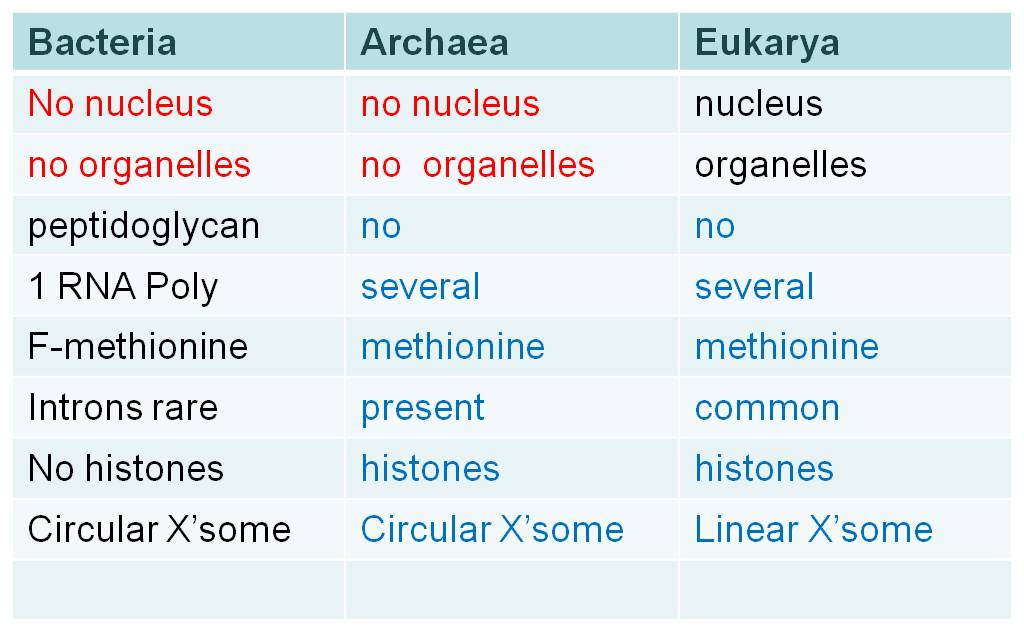 These
two domains are ancient; they may even have diverged before 3.5 bya. The problem
with using genetic clocks and genetic similarity to attempt to date this point
of genetic divergence on these groups is that prokaryotes exchange DNA "laterally".
They don't just pass it down a lineage from parental cell to daughter cells;
they can also pass genes from one living bacterium to another through conjugation
or transformation. As such, genetic similarity can occur as a result of lateral
gene transfer between unrelated organisms, and thus the degree of genetic similarity
in particular genes does not necessarily indicate the degree of common ancestry.
For these reasons, it is very difficult to use this particular technique to
date the time of divergence of these two ancient groups.
These
two domains are ancient; they may even have diverged before 3.5 bya. The problem
with using genetic clocks and genetic similarity to attempt to date this point
of genetic divergence on these groups is that prokaryotes exchange DNA "laterally".
They don't just pass it down a lineage from parental cell to daughter cells;
they can also pass genes from one living bacterium to another through conjugation
or transformation. As such, genetic similarity can occur as a result of lateral
gene transfer between unrelated organisms, and thus the degree of genetic similarity
in particular genes does not necessarily indicate the degree of common ancestry.
For these reasons, it is very difficult to use this particular technique to
date the time of divergence of these two ancient groups.
Although they share some fundamental similarities like the lack of a nucleus, the lack of membrane-bound organelles, and circular chromosomes, these two prokaryotic domains differ in some important respects. When they differ, the archaeans are often similar to the Eukarya. For example, bacteria have peptidoglycan in their cell walls, while archaeans (and eukaryotes) do not. Bacteria have only one type of RNA Polymerase; archaeans (and eukaryotes) have several. Bacteria use formyl-methionine as the initiator amino acid in translation, archaeans (and eukaryotes) use methionine. Histones are not associated with bacterial chromosomes, but they are associated with archaean (and eukaryote) chromosomes. Introns are rare in bacterial genes, but are progressively more common in archaeans and eukaryotes. So, there are several fundamental differences between these two groups, and often the archaeans are more similar to eukaryotes than to bacteria.
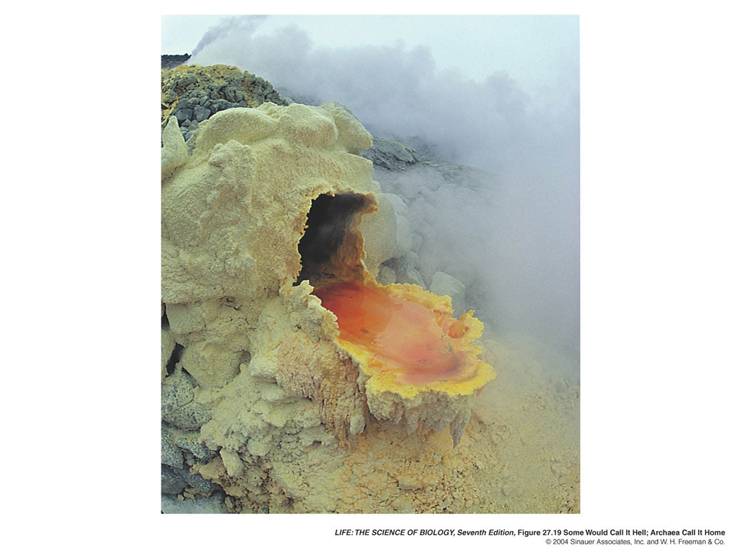 B. Metabolic
Diversity in the Prokaryotes
B. Metabolic
Diversity in the Prokaryotes
If we examine the morphological diversity in prokaryotes, we find round (coccus), rod-shaped (bacillus), and spiral (spirochaete). That is not a lot of morphological diversity! So how have the prokaryotes been changing over the last 3.5 by? Well, they have been evolving metabolically. The theme of bacteria diversity is metabolic diversity. There are very few metabolic processes that eukaryotes can perform that prokaryotes cannot. However, the reverse is not true; the prokayotes have a wide range of metabolic diversity - a range that, in many respects, exceeds the metabolic diversity of eukaryotes.
1. Requirements of Oxygen for Cellular Respiration
Consider types of respiration. There
are no anaerobic eukaryotes. Most eukaryotes require oxygen (they have mitochondria,
after all), although some can function without it for a short time (facultative
anaerobes like yeast). Prokaryotes, on the other hand, have a wide range of
'respiratory' strategies:
- some bacteria, like methanogens, cannot live in the presence of oxygen - obligate
anaerobes
- some bacteria can tolerate oxygen
but don't use it - aerotolerant
- some bacteria can live with or without oxygen - facultative aerobes
- some bacteria live only in the presence of oxygen - obilgate aerobes
2. Ecological Roles
- primary producers: bacteria still make a significant contribution to the absorption of CO2 and the production of oxygen on our planet - largely in the oceans. And these oceanic bacteria are the bottom of marine food chains.
- nitrogen-fixing bacteria: can convert N2 into NH3 (ammonia) and then NO3 (nitrates) which can be taken up by plants. Only bacteria can do this; and so all new, natural inputs of nitrogen to the biosphere are by bacteria. (Lots of biologically accessible nitrogen is added to the environment by humans - through fertilizer and the production of NOx compounds by internal combustion engines).
- decomposers: as consumers of dead organic matter, bacteria (and fungi) break down complex organics and harvest energy. And the byproducts of that digestion are mineral nutrients (N, P, K) that are made available for reuptake in the biosphere by plants. So, bacteria are needed for nutrients to cycle through ecosystems.
- pathogenic bacteria: these bacteria get energy from living tissue and destroy cells in the process; they also produce either exotoxins that they secrete, or endotoxins that are bound to the cell wall. Examples of these pathogenic bacterial diseases are: staph infections, salmonella, typhoid, cholera, scarlet fever, tetanus, tuberculosis, botulism, gonorrhea, and syphilis.
- symbiotes: there are gut bacteria in nearly all animals that assist with digestion and may be required for the production and absorption of certain metabolites.There are also bacterial symbionts in plants, protists, and fungi.
As such, bacteria interact in every way possible with other organisms, and form the 'hub' of the biosphere. In some ways, the evolution of life has been an "embellishment" of the bacterial ecosystems that dominated the planet for the first 2.3 billion years of life.
The take home message about prokaryotes is their metabolic diversity. For 1.8 billion years, life on Earth was SOLELY bacterial. How was it evolving? How was it responding to the environment? Well, it seems that life was responding metabolically, adapting by exploiting different environments and energy sources in different ways.
The eukaryotes have been evolving for at least 2.0 billion years. As you might expect (as was argued for the prokaryotes groups), there has been considerable divergence within this group, producing a dramatic range of genetic and metabolic variation. And of course, the multicellular eukaryotes evolved from protistan ancestors - so multicellular eukaryotes (plants, fungi, and animals) are included within this clade. So, the focus will be on the origin of the clade (Eukarya) and the diversity within this clade. We will pay particular attention to the sister groups of the multicellular "kingdoms" that we will consider in greater detail in the remaining lectures. Obviously, the features that distinguish eukaryotes from archaean ancestors are the presence of membrane-bound organelles (mitochondria and chloroplasts) and a nucleus. So, any hypothesis of origin must explain how these defining structures came into existence.
1. Origin of Organelles
The origin of eukaryotic cells is described by the Endosymbiotic Theory, popularized by Lynn Margulis in the 1960's. It states that organelles are descended from free-living bacterial cells that were absorbed by - or parasitized - archaeans. The evidence for this idea is very strong. Both mitochondria and chloroplasts have double membranes. The outer membranes are similar to the plasma membrane of eukaryotes and archaeans. The inner membrane has certain attributes of bacteria. If a bacterium were absorbed through the process of endocytosis, the bacterium would be surrounded by the membrane of the host's vacuole - creating a double membrane. In addition, both types of organelles have their own DNA, which is circular like bacterial DNA. Both mitochondria and chloroplasts divide by fission, independent of the mitotic division of the eukaryotic cell they inhabit. Over the course of evolutionary history, genes have been exchanged between the organelles and the nucleus, or have been eliminated in the organelle because they also exist in the nucleus. For these reasons, the organelles are functionally dependent on the eukaryotic cell and can no longer live independently for very long.
Additional similarities link these organelles to specific bacteria. Mitochondria not only have their own DNA, but they also produce their own proteins using these DNA recipes. (That should be no surprize!) Protein synthesis occurs on ribosomes within the mitochondria, and their ribosomes are more similar to bacterial ribosomes than to the ribosomes in the cytoplasm of their eukaryotic host cells (produced by the nuclear DNA). Likewise, the genetic code used by mitochondria has a few differences from the universal genetic code; differences also seen in the proteobacteria. Genetic analyses suggest that mitochondria are most closely related to Rickettsia proteobacteria. Rickettsia does not causes "rickets" (a vitamin-D deficiency); rather, Rickettsia bacteria cause a variety of human diseases like many forms of tick-borne fevers (Rocky Mountain spotted fever) and typhus. In addition to having a similar genome to mitochondria, these bacteria are obligate intracellular parasites - so they move into eukaryotic cells and become "organelle-like". In addition, Rickettsia produce ATP in the same way that mitochondria do. So, it is possible that archaeans absorbed bacteria and used them for ATP production, or that the bacteria infected the archaeans to consume their sugars, or some combination of these scenarios. In any case, the bacteria and archaean ultimately benefitted from the interaction, forming a mutualistic or "symbiotic" relationship.
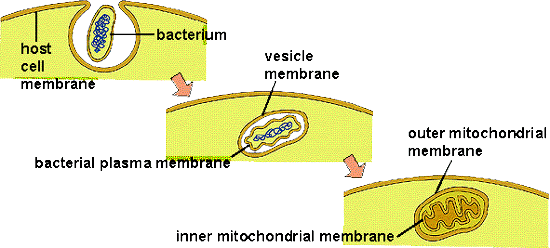 |
 |
Chloroplasts have an independent, endosymbiotic origin; they are genetically similar to a different group of bacteria called cyanobacteria. Some have a double membrane like mitochondria. However, in some protistan groups, the chloroplasts have 3 or 4 membranes, suggesting multiple rounds of endosymbiosis. So, the current model of chloroplast ancestry suggests a single origin of photosynthetic red and green algae. Green algae were then absorbed (secondary endosymbiosis) by other unrelated protists, creating the euglenids and chlorarachniophytes. These organisms are not related directly through nuclear genetic analysis, but they have very similar, multi-membraned chloroplasts - suggesting independent endocytosis of green algae. A similar process may explain the chloroplast similarity in the stramenopiles, apicomplexans and dinoflagellates - independent endocytosis of a red algae could explain their dissimilar nuclear DNA and their similar, multi-membraned chloroplasts.
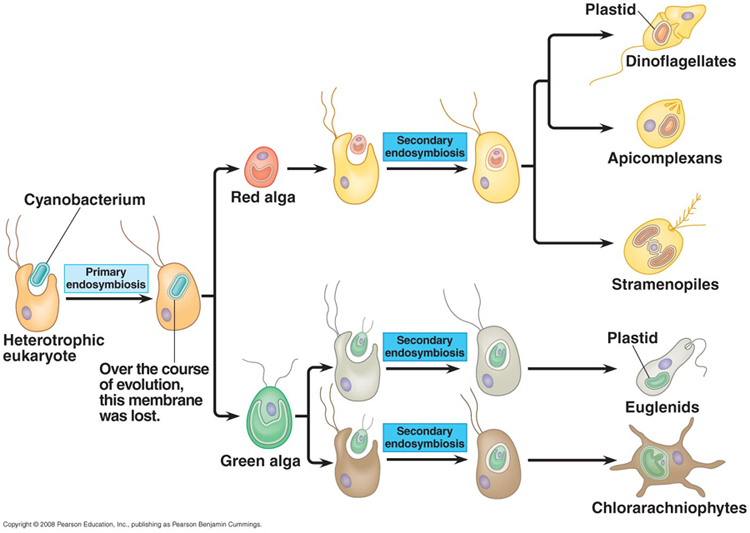
There are several groups of eukarya; most of them contain only single-celled representatives.
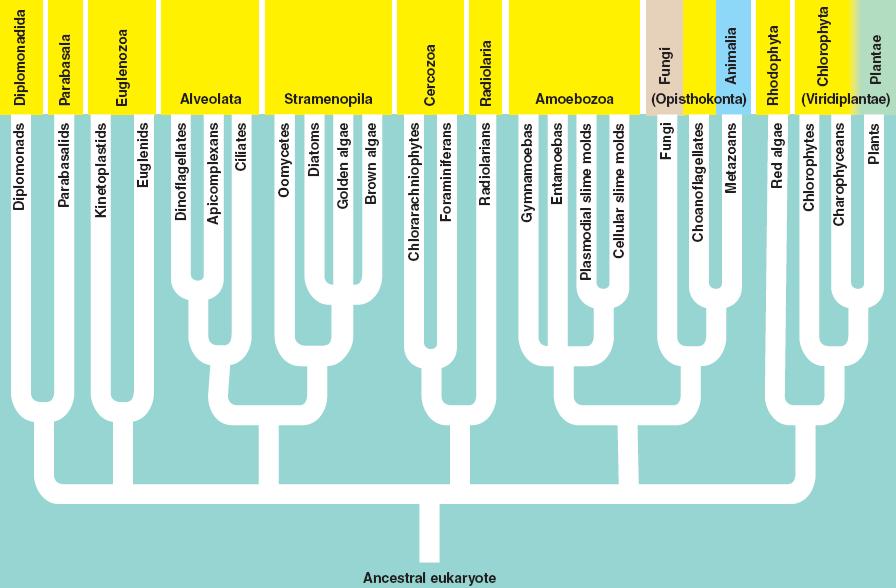
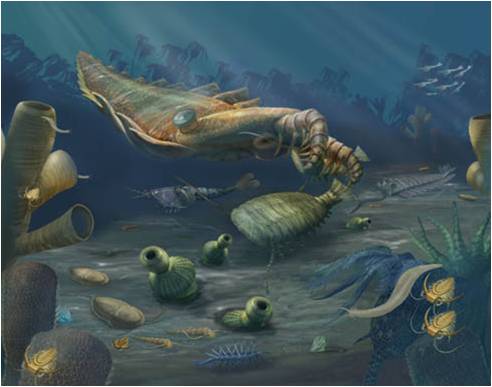 Animal
fossils become much more abundant in the fossil record 550 mya. Although there
are older fossils of soft -bodied jellyfish and worms, the fossil record seems
to 'explode' about 550 mya - an observation that led early Paleotologists to
demarcate this as the beginning of the Paleozoic Era. This explosion probably
occurred because some animals - notably arthropods and molluscs - evolved a
protective body covering (exoskeleton or shell, respectively) that protected
them against the stinging cnidarian predators. The radiation of these groups
left a disproportionate mark on the fossil record because hard parts fossilize
much more readily than soft tissue. So, in part, the 'Cambrian Explosion' is
probably due to sampling bias - organisms evolved that were more likely to fossilize,
so we see more fossils. The evolution of arthropods in the Cambrian led to an
explosion of diversity that is still occurring today - over 85% of the animal
species named to date are Arthropods. In the figure to the right, we see an
artists depiction of the Cambrian Period, with a variety of sponges, cnidarians,
molluscs, and arthropods, including the large predatory arthropod, Anomalocaris - that grasped other animals with its raptorial claws and crushed them in their
circular jaws.
Animal
fossils become much more abundant in the fossil record 550 mya. Although there
are older fossils of soft -bodied jellyfish and worms, the fossil record seems
to 'explode' about 550 mya - an observation that led early Paleotologists to
demarcate this as the beginning of the Paleozoic Era. This explosion probably
occurred because some animals - notably arthropods and molluscs - evolved a
protective body covering (exoskeleton or shell, respectively) that protected
them against the stinging cnidarian predators. The radiation of these groups
left a disproportionate mark on the fossil record because hard parts fossilize
much more readily than soft tissue. So, in part, the 'Cambrian Explosion' is
probably due to sampling bias - organisms evolved that were more likely to fossilize,
so we see more fossils. The evolution of arthropods in the Cambrian led to an
explosion of diversity that is still occurring today - over 85% of the animal
species named to date are Arthropods. In the figure to the right, we see an
artists depiction of the Cambrian Period, with a variety of sponges, cnidarians,
molluscs, and arthropods, including the large predatory arthropod, Anomalocaris - that grasped other animals with its raptorial claws and crushed them in their
circular jaws.
Animals are a fairly recent addition to the living world. They are not very genetically or metabolically diverse when compared to prokaryotes or protists that have much longer evolutionary histories. However, animals are structurally diverse. They have radiated into a wide variety of shapes through changes in developmental patterning. These different shapes have allowed them to exploit a wide range of habitats and resources. Animals are classified into phyla based on their shape or body plan. As heterotrophs, these differences often correlate with differences in feeding structures or locomotory structures that they use to capture food.
From our vantage point as large terrestrial organisms, we have a very skewed view of animal diversity. This is represented by our casual division of animals into 'vertebrates' (like us) and 'invertebrates' (other stuff not like us). These are not phylogenetic groups. The Vertebrata is one sub-phylum of the phylum Chordata, which is one of 32 phyla of animals. The two other sub-phyla of Chordates, and all the other 31 phyla, are 'invertebrate' - and they obviously represent the bulk of animal diversity. Indeed, 95% of all animal species are 'invertebrates', with 85%, as mentioned, occurring in the single phylum Arthropoda. In addition, most animal phyla are exclusively marine - so we rarely encounter them. As you look through the groups pictured at the top of the page (the protostome phyla), you'll see that most animals are rather simple, bilaterally symmetrical, worm-like organisms with different feeding structures.
1. Body Plans
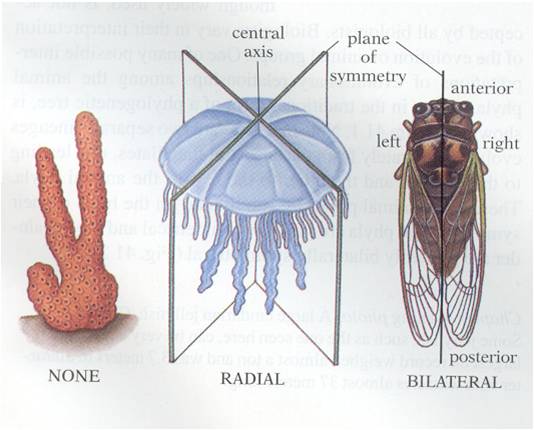 Animals
exibit a wide range of shapes, but these shapes can be classified in three major
groups. First, the sponges are asymmetrical. Second, the cnidarians (jellyfish, corals, sea anemones)
are 'radially symmetrical. This means that, if you are looking down on the organism
from the top, you could cut the organism is half along any axis passing through
the midpoint and the two halves would be be the same. The rest of the animals
are bilaterally symmetrical. This means that there is only one plane of division
that will create to symmetrical 'sides' (bi-lateral = two sides). Given the
fact that the vast majority of animal phyla are bilaterally symmetrical, we
can hypothesize that this evolutionary innovation was functionally important
- allowing animals to work "better", somehow. But how?
Animals
exibit a wide range of shapes, but these shapes can be classified in three major
groups. First, the sponges are asymmetrical. Second, the cnidarians (jellyfish, corals, sea anemones)
are 'radially symmetrical. This means that, if you are looking down on the organism
from the top, you could cut the organism is half along any axis passing through
the midpoint and the two halves would be be the same. The rest of the animals
are bilaterally symmetrical. This means that there is only one plane of division
that will create to symmetrical 'sides' (bi-lateral = two sides). Given the
fact that the vast majority of animal phyla are bilaterally symmetrical, we
can hypothesize that this evolutionary innovation was functionally important
- allowing animals to work "better", somehow. But how?
Bilateral symmetry does more than create two sides; it also means that there is a top and bottom, and a front and back. As heterotrophs, most animals have to moving through the environment in search for their food. Having a 'front' would favor the concentration of sensory systems at this end - so that the animal could perceive the environment that it was about to enter and search for food and avoid predators. So, bilateral symmetry is associated with the formation of a head and the evolution of a brain for processing all this sensory information and directing locomotion. It is no coincidence, therefore, that bilateral symmetry allowed some animals to "get a-head". hahaha.
2. Insects
Half of all species are insects. They are small (so populations split easily), they are tough and can tolerate lots of environments (with an exoskeleton), and they produce lots of eggs so that, if they get somewhere new, they can establish a population quickly. They come in many shapes and sizes, but apparently it's the characteristics listed above that has led to their incredible diversity.
3. Vertebrates
Vertebrates represent the evolutionary lineage that went in the other direction: not towards a sedentary lifestyle but towards an active lifestyle. For the remainder of this unit, we will look at the evolutionary radiations within the vertebrates. We will see a typical pattern throughout this unit. A new group will evolve a novel trait or way of life. This will allow it to use a new environment, or use the environment in a new way. These lifestyles are called "adaptive zones", and they relate to ecological niches. Creation or entry into a new niche or zone means that there is no competition for resources. Under these conditions, almost any strategy using this new novel innovation will work - typically we see a radiation of new species exploiting this new way of life. As this adaptive zone or niche fills with species, they begin to compete. This leads to 'competitive contraction' of diversity, with only a few winners. The same thing happens in any situation where there are potentially limted resources. A new innovation, like the internet, provides opportunities to new businesses. Many flourish initially - like the many browser providers that were present in the '90's. Anyone remember when Netscape was the primary internet provider? Economists call that period the "dot-com boom", when internet companies could get a start just by colonizing this new open marketplace. As companies grew, they began to compete; and there were winners that maintained their position in the niche, and losers that went extinct. The same thing can happen in ecological systems. Competitive contraction can occur within a clade, or as a consequence of a more efficient, new evolutionary novelty arising. Henry Ford's Model T not only put many other car makers out of business, it also puts LOTS of horse-driven carriage companies out of business! So, as a more advanced, efficient group evolves, we sometimes see contraction in the abundance of ancestral forms... just as Darwin predicted.
 The
jawless fishes: The vertebrates are distinguished by having an internal supportive spine that
is subdivided into units called vertebrae. This segmentation of the vertebral
column allows the animal to bend and move with more precision; with some parts
of the body moving while other parts remain stationary. The most primitive members
of this clade are the jawless fishes. The modern representatives are the hagfish
and the lampreys. The hagfish actually lack a subdivided vertebral column, but
they do have a skull surrounding their brain. As such, sometimes the "vertebrata"
are more specifically described as having a skull (to include the hagfish).
Both hagfish and lampreys have immature stages that look almost identical to
cephalochordates, also suggesting their primitive position within this clade.
So, the jawless fish evolve in the Cambrian and radiate in the Ordovician and
Silurian Periods, with many large, detritivorous and filter feeding species
scouring the benthos for food. In more advanced forms, the mouth cavity and
pharynx evolved for feeding, relieving the gills of this filtering function.
These jawless fish probably sucked in small invertebrates by rapidly opening
their mouth.
The
jawless fishes: The vertebrates are distinguished by having an internal supportive spine that
is subdivided into units called vertebrae. This segmentation of the vertebral
column allows the animal to bend and move with more precision; with some parts
of the body moving while other parts remain stationary. The most primitive members
of this clade are the jawless fishes. The modern representatives are the hagfish
and the lampreys. The hagfish actually lack a subdivided vertebral column, but
they do have a skull surrounding their brain. As such, sometimes the "vertebrata"
are more specifically described as having a skull (to include the hagfish).
Both hagfish and lampreys have immature stages that look almost identical to
cephalochordates, also suggesting their primitive position within this clade.
So, the jawless fish evolve in the Cambrian and radiate in the Ordovician and
Silurian Periods, with many large, detritivorous and filter feeding species
scouring the benthos for food. In more advanced forms, the mouth cavity and
pharynx evolved for feeding, relieving the gills of this filtering function.
These jawless fish probably sucked in small invertebrates by rapidly opening
their mouth.
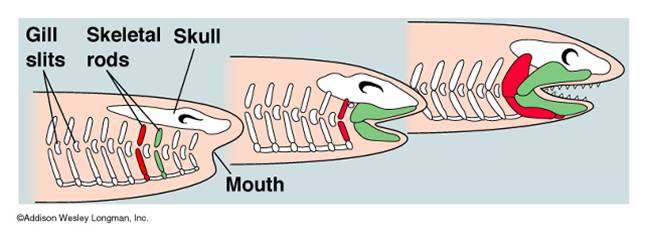 The
Gnathostomes: The Jawed Vertebrates: Jawed fishes evolved
in the Silurian and came to dominate and radiate in the Devonian - the "Age
of Fishes". Jaws evolved from the anterior gill arches, which flex and
became associated withe the mouth. Jaws allowed fish to become more efficient
predators, killing things bigger than could fit in their mouth through suction,
or strong enough to escape the suctioning force. In short, jaws were adaptive
because fish now became mobile, active predators - entering a niche previously
only occupied by large invertebrate predators. The first jawed fish radiation
were the placoderms, symbolized by the frightening Arthrodire predators like Dunkleosteus, with its huge slicing jaw plates. The placoderms were
very heavy, however, and were displaced by more efficient swimmers - the cartilaginous
jawed fishes (Class Chondrichthyes). Modern representatives of this group are
sharks and rays.
The
Gnathostomes: The Jawed Vertebrates: Jawed fishes evolved
in the Silurian and came to dominate and radiate in the Devonian - the "Age
of Fishes". Jaws evolved from the anterior gill arches, which flex and
became associated withe the mouth. Jaws allowed fish to become more efficient
predators, killing things bigger than could fit in their mouth through suction,
or strong enough to escape the suctioning force. In short, jaws were adaptive
because fish now became mobile, active predators - entering a niche previously
only occupied by large invertebrate predators. The first jawed fish radiation
were the placoderms, symbolized by the frightening Arthrodire predators like Dunkleosteus, with its huge slicing jaw plates. The placoderms were
very heavy, however, and were displaced by more efficient swimmers - the cartilaginous
jawed fishes (Class Chondrichthyes). Modern representatives of this group are
sharks and rays.
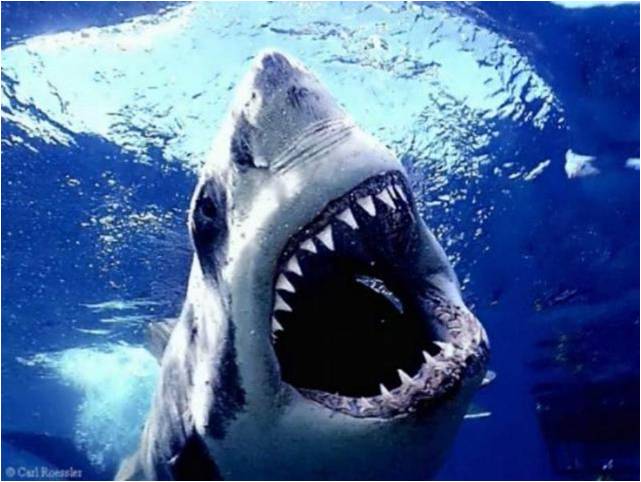 The
Devonian also saw the radiation of the most successful group of fish on earth,
the bony fish (Class Osteichthyes). Unlike cartilage, bone is hollow and light;
it is also more rigid than cartilage, providing more resistance and efficiency
to muscles. The bony fish also had a swim bladder, whcih they used to maintain
neutral bouyancy in the water column. This means that they can maintain position
without swimming; Condrichthyes must swim to maintain vertical position in the
water column - otherwise they sink. These two adaptations of the bony fishes
made them more energetically efficient and faster than the cartilaginous fish,
and the bony fishes have radiated to the point where they represent 40% of all
vertebrate species today (not just fish - vertebrates..!!). Two important clades
evolved within the bony fishes: 1) the ray-finned fishes that came to dominate
the aquatic environments of the planet; and 2) the lob-finned fishes that radiated
into shallow-water environments. The lobe-finned fishes, swimming in shallow,
oxygen-poor waters of the Devonian, gulping air at the surface and pulling themselves
along on their forefins, evolved into the terrestrial tetrapods. Arthropods
had already colonized land, so there was ample food and oxygen for a large terrestrial
predator. As you have seen, the fossil record nicely documents the transition
from fish to these primitive amphibians.
The
Devonian also saw the radiation of the most successful group of fish on earth,
the bony fish (Class Osteichthyes). Unlike cartilage, bone is hollow and light;
it is also more rigid than cartilage, providing more resistance and efficiency
to muscles. The bony fish also had a swim bladder, whcih they used to maintain
neutral bouyancy in the water column. This means that they can maintain position
without swimming; Condrichthyes must swim to maintain vertical position in the
water column - otherwise they sink. These two adaptations of the bony fishes
made them more energetically efficient and faster than the cartilaginous fish,
and the bony fishes have radiated to the point where they represent 40% of all
vertebrate species today (not just fish - vertebrates..!!). Two important clades
evolved within the bony fishes: 1) the ray-finned fishes that came to dominate
the aquatic environments of the planet; and 2) the lob-finned fishes that radiated
into shallow-water environments. The lobe-finned fishes, swimming in shallow,
oxygen-poor waters of the Devonian, gulping air at the surface and pulling themselves
along on their forefins, evolved into the terrestrial tetrapods. Arthropods
had already colonized land, so there was ample food and oxygen for a large terrestrial
predator. As you have seen, the fossil record nicely documents the transition
from fish to these primitive amphibians.
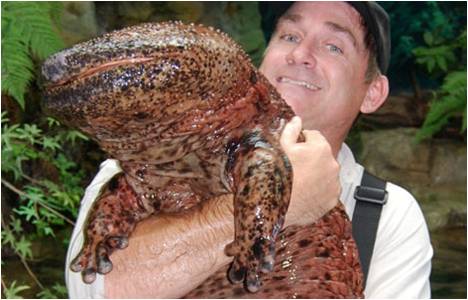 The
Tetrapods: The
tetrapod clade includes all vertebrates descended from the first animals to
walk on land. The radiation of early tetrapods is very impressive; the adaptive
zone of the Carboniferous swamps was very large and well-suited to amphibian
animals reliant on water to lay their eggs. In addition, the huge amount of
biological productivity (lots of photosynthesis and less decompostion, remember?)
led to large populations of herbivorous insects that were eay prey for large
land vertebrates. The Carboniferous could well be called the "Age of Amphibians".
Many groups of early 'amphibians' radiate during this period, collectively called
the 'stem tetrapods'. However, the dry periods of the Permian and Mesozoic were
not optimal for these animals limited to areas near water. Today, three groups
of amphibians remain. The Caecilians are unusual, rare, legless amphibians.
Salamanders are the second group, and the giant Japanese salamander is the largest
living amphibian - reaching six feet in length! The most diverse group is the
Anura - mening "tailless" - the frogs and toads. Most amphibians have
gills or lungs at some point in their life cycle, but many also (or exclusively)
respire through their skin. For this to happen, the gases must diffuse into
a thin film of water, and then move across cell membranes by diffusion. So,
most amphibians need to keep their skin moist to respire; and it also means
that their skin, as an absorptive surface, is also prone to absorb toxins in
the environment. For these reasons, amphibians are particularly sensitive to
pollutants and environmental contaminants. Over the last 50 years, there has
been a dramatic decline in amphibian populations worldwide, probably due to
exposure to human-produced pollution, climate change, and chytrid fungal infections.
It is tough to say which of these variables is 'most' responsible for the decline.
In all likelihood, each factor increases sensitivity to the other two. In any
case, these three factors are having a decimating effect on amphibian populations.
The
Tetrapods: The
tetrapod clade includes all vertebrates descended from the first animals to
walk on land. The radiation of early tetrapods is very impressive; the adaptive
zone of the Carboniferous swamps was very large and well-suited to amphibian
animals reliant on water to lay their eggs. In addition, the huge amount of
biological productivity (lots of photosynthesis and less decompostion, remember?)
led to large populations of herbivorous insects that were eay prey for large
land vertebrates. The Carboniferous could well be called the "Age of Amphibians".
Many groups of early 'amphibians' radiate during this period, collectively called
the 'stem tetrapods'. However, the dry periods of the Permian and Mesozoic were
not optimal for these animals limited to areas near water. Today, three groups
of amphibians remain. The Caecilians are unusual, rare, legless amphibians.
Salamanders are the second group, and the giant Japanese salamander is the largest
living amphibian - reaching six feet in length! The most diverse group is the
Anura - mening "tailless" - the frogs and toads. Most amphibians have
gills or lungs at some point in their life cycle, but many also (or exclusively)
respire through their skin. For this to happen, the gases must diffuse into
a thin film of water, and then move across cell membranes by diffusion. So,
most amphibians need to keep their skin moist to respire; and it also means
that their skin, as an absorptive surface, is also prone to absorb toxins in
the environment. For these reasons, amphibians are particularly sensitive to
pollutants and environmental contaminants. Over the last 50 years, there has
been a dramatic decline in amphibian populations worldwide, probably due to
exposure to human-produced pollution, climate change, and chytrid fungal infections.
It is tough to say which of these variables is 'most' responsible for the decline.
In all likelihood, each factor increases sensitivity to the other two. In any
case, these three factors are having a decimating effect on amphibian populations.
The Amniota: Within the tetrapods, a new type of animal evolved in the Carboniferous; an animal that laid an egg surrounded by a series of membranes and a shell. These layers served to protect the developing embryo and yolk sac from dessication, allowing these species to colonize land further from water and exploit food resources and habitats that amphibians could not reach. This clade of animals is the amniotes, and their evolutionary innovation is the amniotic egg. The primitive condition within this group probably produced a leathery covering, much like turtles. A more rigid, desiccation resistant egg like birds have is probably a derived trait, as is the retention of the egg and live bearing of young, as seen in some snakes, and most mammals. The amniotes radiated during the Permian Period, when the drying of the unified land mass of Pangaea gave them a decided advantage over the ancestral, amphibious tetrapods. Three groups evolved at this time, distinguished by their skull morphology.
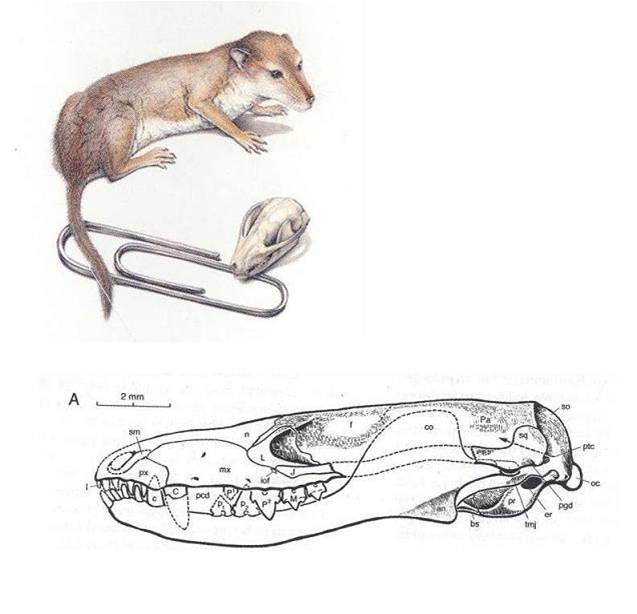 The
Synapsids and the Mammals: The first group to dominate
were the synapsids. They dominated during the Permian, and were represented
by the great "sail-finned" Pelycosaurs and the Therapsid lineages
(the Gorgonopsians, the Dicynodonts, and the Cynodonts). The synapsid lineage
that is alive today are the Mammals. The transition from ancestral to derive
synapsids is well preserved in the fossil record, documenting the evolution
of the inner ear from the ancestral jaw bones, and the evolution of complex
and specialized dentition. The first true mammals are the Morganucodonts that
evolved in the Jurassic Period of the Mesozoic, about 200 mya. Ancestral synapsids
were large carnivores that dominated the landscape; a niche that would be filled
by the diapsid dinosaurs during the Mesozoic. The mammals were small, noctural
insectivores and scavengers. They radiated into these niches in the Jurassic,
perhaps because their endothermy allowed them to use the cool night more effectively
and under cover of darkness from larger predators. The surviving lineage of
this radiation are the three species of monotremes alive today: the platypus
and two species of echidna. These mammals lay eggs. Their offspring hatch, and
then nuzzle the belly of their mothers. Their mothers have sweat glands that
have evolved to produce a nutrient rich milk - they are mammary glands. However,
even the modern representatives lack nipples on these glands - so they "sweat"
milk onto their belly and the the hatchlings lick it up. Placental and marsupial
mammals evolved later, in the Cretaceous Period. Marsupials do not lay eggs;
they give live birth to a very small, embryonic newborn. The newborn climbs
from the genital opening to the pouch - a flap of skin covering the nipples
of the mammary glands. The embryo attaches to a nipple and feeds nearly continuously,
completing development in the pouch. This allows the mother to carry the embryo
with her for a longer period; there are no eggs that must be left periodically
for the mother to feed. The last group of mammals, the placentals, also retain
the embryo and give live birth. However, they retain the embryo much longer,
often until the offspring is capable of independent activity. The efficient
feeding of the embryo is facilitated by the placenta - which allows nutrients
in the bloodstream of the mother to pass directly into the bloodstream of the
offspring. This is far more efficient, energetically, than the mother turning
the nutrients into milk, that must be consumed and digested by the offspring.
So, placental mammals can develop more rapidly than marsupials. Some placentals
produce offspring that can walk immediately; these are precocial young. Other
species, like cats and humans, produce offspring that still need considerable
parental care. These offspring are called altricial.
The
Synapsids and the Mammals: The first group to dominate
were the synapsids. They dominated during the Permian, and were represented
by the great "sail-finned" Pelycosaurs and the Therapsid lineages
(the Gorgonopsians, the Dicynodonts, and the Cynodonts). The synapsid lineage
that is alive today are the Mammals. The transition from ancestral to derive
synapsids is well preserved in the fossil record, documenting the evolution
of the inner ear from the ancestral jaw bones, and the evolution of complex
and specialized dentition. The first true mammals are the Morganucodonts that
evolved in the Jurassic Period of the Mesozoic, about 200 mya. Ancestral synapsids
were large carnivores that dominated the landscape; a niche that would be filled
by the diapsid dinosaurs during the Mesozoic. The mammals were small, noctural
insectivores and scavengers. They radiated into these niches in the Jurassic,
perhaps because their endothermy allowed them to use the cool night more effectively
and under cover of darkness from larger predators. The surviving lineage of
this radiation are the three species of monotremes alive today: the platypus
and two species of echidna. These mammals lay eggs. Their offspring hatch, and
then nuzzle the belly of their mothers. Their mothers have sweat glands that
have evolved to produce a nutrient rich milk - they are mammary glands. However,
even the modern representatives lack nipples on these glands - so they "sweat"
milk onto their belly and the the hatchlings lick it up. Placental and marsupial
mammals evolved later, in the Cretaceous Period. Marsupials do not lay eggs;
they give live birth to a very small, embryonic newborn. The newborn climbs
from the genital opening to the pouch - a flap of skin covering the nipples
of the mammary glands. The embryo attaches to a nipple and feeds nearly continuously,
completing development in the pouch. This allows the mother to carry the embryo
with her for a longer period; there are no eggs that must be left periodically
for the mother to feed. The last group of mammals, the placentals, also retain
the embryo and give live birth. However, they retain the embryo much longer,
often until the offspring is capable of independent activity. The efficient
feeding of the embryo is facilitated by the placenta - which allows nutrients
in the bloodstream of the mother to pass directly into the bloodstream of the
offspring. This is far more efficient, energetically, than the mother turning
the nutrients into milk, that must be consumed and digested by the offspring.
So, placental mammals can develop more rapidly than marsupials. Some placentals
produce offspring that can walk immediately; these are precocial young. Other
species, like cats and humans, produce offspring that still need considerable
parental care. These offspring are called altricial.
The Diapsids: The other major group of amniotes are the diapsids. They radiated into two major groups, the lepidosaurs that walked with their legs splayed out and the archosaurs that walked with their legs underneath.
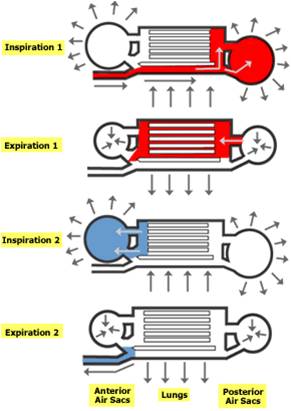 The
archosaurs would dominate during the Mesozoic Era, with the great
radations of the Crocodylomorphs, Pterosaurs, and Dinosaurs. Two groups of Archosaurs
persists today - the crocodilians (caimen, gavials, alligators, and crocodiles),
and the birds. Although several groups of dinosaurs evolved feathers - probably
first for attracting mates or communicating, and then for insulation - only
in the birds did these feathers evolve for powered flight. Associated shared
derived characters are light, hollow, fused bones, the fusion of digits in the
forelimbss, a keeled sternum for anchoring large breast muscles used for flight,
and a 'wishbone' - a union of the two clavicles that acts like a spring during
the flight stroke. The loss of teeth is also a derived trait in this group,
as is the evolution of an interesting respiratory system of air sacs. Birds
have a one way lung. Air that's inhaled goes to a posterior air sac. On the
first exhalation, air is moved forward through the lung. The second inhalation
refills the posterior air sac, and the next exhalation pulls deoxygenated air
forward into the anterior air sac and out of the animal. This modification,
like a one-way digestive tract, improves the efficiency of the organ. Now, the
air in the lung is always oxygenated; it is not mixed with deoxygenated air
like in the sac-like lungs of other animals. It's not surprizing that birds
would evolve this system, as the metabolic demands of flight are much more significant
than other forms of locomotion.
The
archosaurs would dominate during the Mesozoic Era, with the great
radations of the Crocodylomorphs, Pterosaurs, and Dinosaurs. Two groups of Archosaurs
persists today - the crocodilians (caimen, gavials, alligators, and crocodiles),
and the birds. Although several groups of dinosaurs evolved feathers - probably
first for attracting mates or communicating, and then for insulation - only
in the birds did these feathers evolve for powered flight. Associated shared
derived characters are light, hollow, fused bones, the fusion of digits in the
forelimbss, a keeled sternum for anchoring large breast muscles used for flight,
and a 'wishbone' - a union of the two clavicles that acts like a spring during
the flight stroke. The loss of teeth is also a derived trait in this group,
as is the evolution of an interesting respiratory system of air sacs. Birds
have a one way lung. Air that's inhaled goes to a posterior air sac. On the
first exhalation, air is moved forward through the lung. The second inhalation
refills the posterior air sac, and the next exhalation pulls deoxygenated air
forward into the anterior air sac and out of the animal. This modification,
like a one-way digestive tract, improves the efficiency of the organ. Now, the
air in the lung is always oxygenated; it is not mixed with deoxygenated air
like in the sac-like lungs of other animals. It's not surprizing that birds
would evolve this system, as the metabolic demands of flight are much more significant
than other forms of locomotion.
The Lepidosaurs also radiated during the Mesozoic, but did not do so as dramatically as the Archosaurs. Today, the surviving representatives are the Squamata (lizards and the derived snakes) and their sister group, the Sphenodonts with two surviving relict species of Tuatara native to New Zealand. The tuatara maintains the most primitive amniote characteristics, and so is very valuable in studying the phylogeny of diapsid reptiles. The derived squamates, the modern lizards and snakes, have scales, a double hinged jaw (particularly important in snakes), and a hinge on the top of their skull.
That concludes a look at the phyla of animals. Next we will take a brief look at the evolutionary history of our own small twig on the mammalian limb.
1. Green Algal Ancestors
There is considerable evidence that plants evolved from green algal ancestors. They share the same type of chloroplasts (with chlorophyll a and b), and an intersting life history called "alternation of generation". In this life cycle, a haploid organism (the gametophyte) produces gametes by mitosis. These gametes fuse in a fertilization event, creating a diploid zygote. This diploid zygote divides (typically) mitotically to produce a multicellular diploid offspring. This organism produces haploid spores by meiosis. These spores develop, dividing mitotically to produce the next multicellular haploid generation. So, the ploidy level "alternates" across the generations.
2. Colonization of Land: Environmental Differences
The evolution of plants occurred as photosynthetic organisms acquired traits that allowed for greater reproductive success on land - out of the ancestral aquatic environment of algae. So, to understand how plants differ from algae, and how and why plants evolved various characteristics, you must understand how aquatic and terrestrial habitats differ. Algae and plants require several essential nutrients: sunlight, water, and mineral nutrients (like nitrogen, potassium, magnesium, and phosphorus, to name a few). They also require CO2 and oxygen, as all green algae and plants are photosynthetic aerobes, having both chloroplasts (for photosynthesis that needs CO2) and mitochondria (for aerobic respiration that needs O2). Aquatic habitats have ample water (obviously). Carbon dioxide dissolves in water, so the concentration in air and water will equilibrate over time. However, CO2 does not diffuse quickly into or through water, so it may be less abundant locally. Likewise, oxygen may be in short supply in aqueous habitats, largely because it does not dissolve as readily. Although oxygen has a concentration of 21% in the atmosphere, it is often about 7% or less in aquatic habitats, with more near the surface and less at increasing water depths. In addition, water absorbs light energy quickly. About 90% of the light energy is absorbed in the first 10m of water; 99% is absorbed by 50-100m. So, photosynthetic organisms must stay near the top of a water column to get light and oxygen. Unfortunately, the process of decomposition that recycles mineral nutrients tends to occur at the bottom of a water column. As such, growth and photosynthesis of aquatic algae is usually strongly limited by mineral nutrients - either phosphorus, nitrogen, or iron. (This is why fertilizers running of into water can create huge algal blooms - the factor previously limiting their growth has been provided, so they grow like crazy). That is why the open ocean has little photosynthetic activity per unit area; especially compared to shallower regions like continental margins and shallow estuaries where upwelling and wave action bring nutrients to the surface and feed local productivity. So, although aquatic habitats have lots of water, terrestrial environments provide more sunlight, more oxygen, the same amount of CO2 (but more equitably distributed and available), and more mineral nutrients (which are eroding from the rocks or are being recycled by decomposers and are present in the soil water). And in shallow-water environments with a supply of nutrients, competition with other algae would become intense, too.
In this context, land looks like a much better habitat for photosynthetic organisms than aquatic habitats. We can appreciate why selection might favor organisms that could colonize this environment. However, there is one significant hurdle - terrestrial environments are very very dry. Living tissue is mostly water; in order to survive in a terrestrial environment, living systems had to evolve mechanisms for reducing water loss. There are other problems that a deficit of water creates, too, like for reproduction. Algae and animals have swimming gametes; how can they reproduce on land? As we consider different groups of plants, we will focus on how plants evolved characteristics that solved these problems.
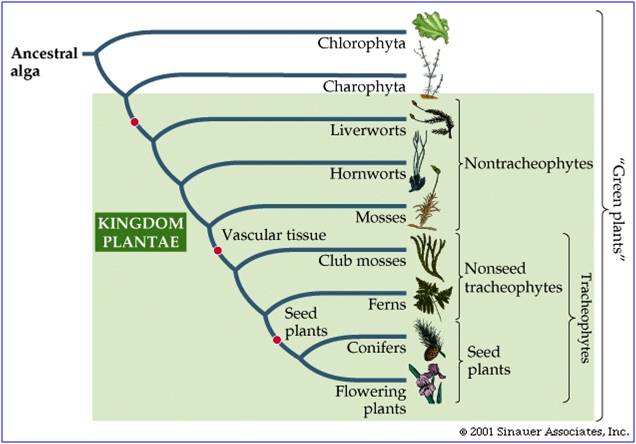 3.
Plant Evolution: Adapting to Land
3.
Plant Evolution: Adapting to Land
The dominant plants on the planet today are the flowering plants (Angiosperms) and the conifers (a group of Gymnosperms). Both groups are fully terrestrial (except those that have recolonized water!), meaning that no stage of their life cycle requires an aquatic habitat to survive. They have a waxy cuticle on their leaves that reduces water loss, and they also have pores ("stomates") that close during dry conditions to reduce water loss still further. They have vascular tissue for the efficient transport of water from the roots to leaves ("xylem" tissue) and to transport sugars from leaves to the rest of the plant ("phloem" tissue). The xylem has cellulose and lignin in the cell walls, creating rigid tissue that can support the weight of the plant. In addition, these plants have non-motile sperm; the sperm is carried to the egg by the male gametophyte organism, the pollen grain. All of these characteristics are adaptations to life on land: reducing water loss, increasing the efficiency of water transport, and reducing dependancy on water as a necessary medium for gamete transport or bodily support. These adaptations did not evolve at once. Rather, through the evolution of different new plant groups, plants evolved and accumulated these adaptations. Today, although angiosperms dominate the plant kingdom, there are still representatives of more ancient groups. As we move through these groups, we will emphasize the major evolutionary innovations of each group.
4. Primitive Plants - the "non-tracheophytes"
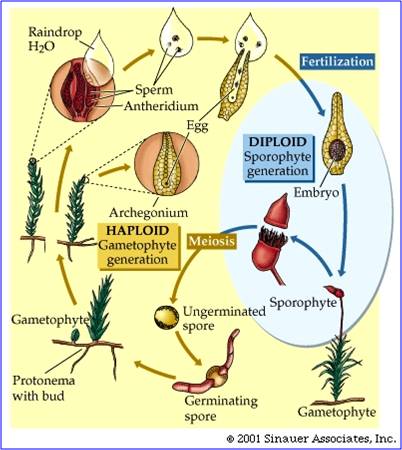 a.
Groups
a.
Groups
These groups are not a 'monophyletic' clade, but we will consider them together. They are the "liverworts", the "hornworts", and the "mosses". You are certainly aware of mosses, but liverworts are quite common, too, living on streambanks or on rocks in streams. Hornworts are a bit less common, but are also found in moist areas, including the bark of some trees.
b. Characteristics
These groups are all non-vascular, meaning that they do not have xylem or phloem. As a consequence, water and sugar transport in the plants is from cell to cell and it is not very efficient. So, the plants must remain small and low to the ground - the source of their water. They also produce swimming sperm, and so must be covered by a thin film of water in order to reproduce. They do not have true leaves or roots (defined as having veins), and so water absorption is inefficient, too. In short, these plants are limited to living in very moist areas, and they must be covered by at least a thin film of water at some time during the year. These plants do have some adaptations for life on land that distinguish them from their algal ancestors, however. They secrete a thin oily cuticle that protects them a bit from water loss. In addition, hornworts and moss sporophytes have stomates - pores in their 'leaflets' to regulate gas exchange and water loss. Their life cycle is dominated by the haploid gametophyte generation; that means that when you are looking at a green moss plant or a liverwort, you are looking at a haploid gametophyte organism. The sporophyte organism is smaller, and is physiologically dependent on the haploid gametophyte parent. In moss, the sporophyte grows out of the archogonium (egg-bearing structure) on the top of the female moss gametophyte. It is brown, and receives the energy it needs to grow from the parent plant. The capsule that it produces is where meiosis occurs, reducing ploidy by 1/2 and producing the haploid spores that will each develop into new haploid gametophyte plants.
5. Tracheophytes
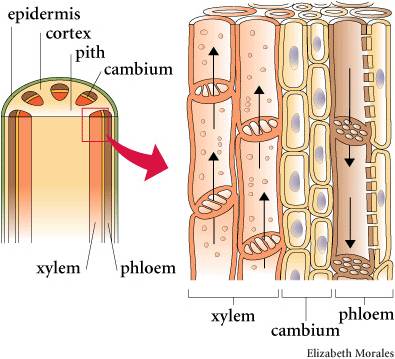 a.
Characteristics
a.
Characteristics
As the name denotes, these are the vascular plants that have true xylem and phloem tissue. Xylem tissue consists of cells that have died, leaving behind their highly lignified cell walls. The ends of these vessel elements have holes, allowing water to pass through like a straw. The evolution of xylem allows for efficient transport of water up a plant. This occurs through root pressure and evapotranspiration from leaves. By actively transporting salts into the xylem cavity, water follows by osmosis from living root tissue and water pressure 'pumps' water up the stem. At the other end of the xylem vessels, water is evaporating off leaves to the environment, creating a negative pressure that 'sucks' water up the stem. Because of the narrowness of the vessel elements, water also moves up by capillary action. All this means that plants could grow taller. This is advantageous for gathering light (the plant is not subject to shading by neighbors) and dispersing spores, but not too great for dispersing swimming sperm.
As such, it is not surprizing that the sporophyte generations becomes the dominant life history stage in tracheophytes. The gametophyte can't take advantage of larger size, because the plant needs to be covered by water for the sperm to swim. The sporophyte, however, benefits from being tall because the increased wind disperses spores farther.
b. Groups:
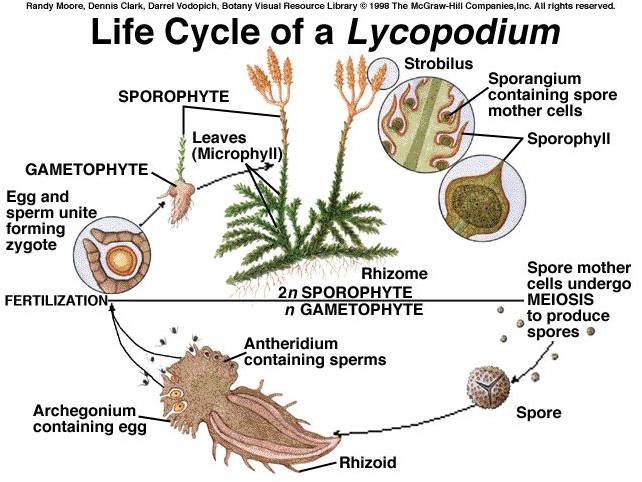 i.
Lycopodiophyta: These are the most primitive living vascular
plants, descended from a very diverse clade that dominated through the late
Silurian, Devonian, and Carboniferous Periods (400-300 mya) of the Paleozoic
Era. The presence of vascular tissue allowed their sporophytes to grow tall;
indeed, the 'arborescent' (tree-like) canopy of Devonian and Carboniferous forests
were clubmosses nearly 100 ft tall. Today, clubmosses are typically under a
foot in height, forming a lush carpet in the herb layer of moist forests. The
life cycle shows this inversion and dominance of the sporophyte. When you are
looking at a green clubmoss plant, you are seeing the diploid sporophyte. It
bears cone-like structures called strobili, and in those structures the sporangia
produce haploid spores by meiosis. The spores germinate, producing a free-living
gametophyte that lives in the soil. Archegonia and antheridia produce eggs and
sperm, respectively, by mitosis. The swimming sperm fertilize the eggs in the
archegonia, and the developing sporophyte grows out of its gametophyte parent,
as in the more primitive true mosses. However, this sporophyte is photosynthetically
active and grows to be a large, physiologically independent organism - it is
not dependent on its gametophyte parent as in true mosses.
i.
Lycopodiophyta: These are the most primitive living vascular
plants, descended from a very diverse clade that dominated through the late
Silurian, Devonian, and Carboniferous Periods (400-300 mya) of the Paleozoic
Era. The presence of vascular tissue allowed their sporophytes to grow tall;
indeed, the 'arborescent' (tree-like) canopy of Devonian and Carboniferous forests
were clubmosses nearly 100 ft tall. Today, clubmosses are typically under a
foot in height, forming a lush carpet in the herb layer of moist forests. The
life cycle shows this inversion and dominance of the sporophyte. When you are
looking at a green clubmoss plant, you are seeing the diploid sporophyte. It
bears cone-like structures called strobili, and in those structures the sporangia
produce haploid spores by meiosis. The spores germinate, producing a free-living
gametophyte that lives in the soil. Archegonia and antheridia produce eggs and
sperm, respectively, by mitosis. The swimming sperm fertilize the eggs in the
archegonia, and the developing sporophyte grows out of its gametophyte parent,
as in the more primitive true mosses. However, this sporophyte is photosynthetically
active and grows to be a large, physiologically independent organism - it is
not dependent on its gametophyte parent as in true mosses.
ii. Monilophytes: These are the ferns and their allies; they form a a monophyletic group of euphyllophyte plants (with true leaves) that, like all plants we have considered, do not produce seeds and have swimming sperm. The other euphyllophytes DO produce seeds, and form the monophyletic group called the Spermatophytes. Some of the Monilophytes, like Equisetum and Psilotum, don't look much like a fern... however, their life cycles, presence of sporangia, and genes show their relationship to the ferns.
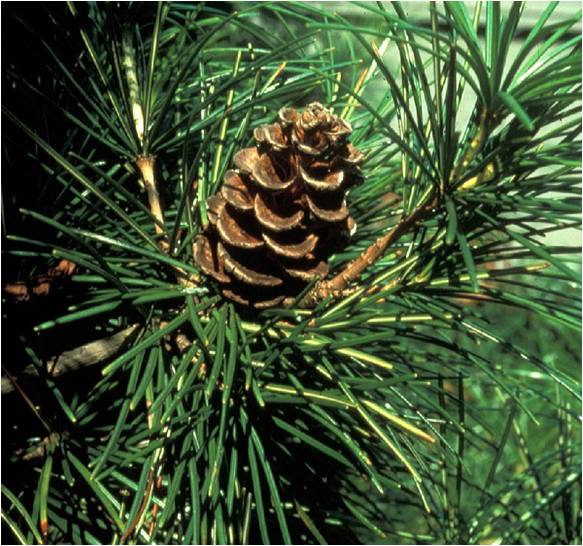 iii.
Gymnosperms: The
gymnosperms evolved during the Carboniferous but came to dominate terrestrial
landscapes during the Permian Period, when the unification of Pangaea created
a drier terrestrial climate. They would continue to dominate through the first
part of the Mesozoic. Modern gymnosperms include the conifers (pines, fir, spruce,
hemlock, yew, redwoods,cedars, cypress, larch, etc.), the cycads, and the Ginkgo
(one relict species). Another group, the Gnetales, contains some very unusual
gymnosperms that have some characteristics of angiosperms. The gymnosperms probably
evolved from an earlier group of plants called the "Seed ferns". Seeds
ferns were the first plants to produce seeds and pollen; characteristics which
would allow their descendants to dominate terrestrial habitats. The seed ferns
are an extinct group, so we will use the modern Gymnosperms to describe the
importance of these key evolutionary innovations.
iii.
Gymnosperms: The
gymnosperms evolved during the Carboniferous but came to dominate terrestrial
landscapes during the Permian Period, when the unification of Pangaea created
a drier terrestrial climate. They would continue to dominate through the first
part of the Mesozoic. Modern gymnosperms include the conifers (pines, fir, spruce,
hemlock, yew, redwoods,cedars, cypress, larch, etc.), the cycads, and the Ginkgo
(one relict species). Another group, the Gnetales, contains some very unusual
gymnosperms that have some characteristics of angiosperms. The gymnosperms probably
evolved from an earlier group of plants called the "Seed ferns". Seeds
ferns were the first plants to produce seeds and pollen; characteristics which
would allow their descendants to dominate terrestrial habitats. The seed ferns
are an extinct group, so we will use the modern Gymnosperms to describe the
importance of these key evolutionary innovations.
The seed: The plants that we have examined so far produce the diploid zygote on the female gametophyte - in the vase-like archegonium. As such, the dispersal phase of the life cycle is the spore. Spores are single celled, and although they may be dessication resistant, once they germinate and begin to grow, they must be able to immediately meet their biological needs with material they absorb from the environment. In the "seed plants" (seed ferns, gymnosperms, and angiosperms), the female gametophyte is retained on the sporophyte plant, and becomes the dispersal vessel for its offspring, the next generation of embryonic sporophyte. Here's what happens: The sporophyte produces two types of spores, large and small. Inside the ovule, a 2n cell (megasporocyte) divides by meiosis. The cytoplasm is divided unequally, producing three reduced non-functional cells and one large functional spore - the megaspore. This megaspore, nested within the ovule, divides mitotically and developes into the female gametophyte. The female gametophyte produces the egg, located at one end of the female gametophyte, within the ovule. Fertilization of the egg by sperm forms the diploid zygote. This divides to become the diploid embryo, all still surrounded by haploid gametophyte tissue, within original 2n ovule tissue. This is the seed: 2n ovule tissue (seed coat), surrounding 1n female gametophyte tissue, surrounding the 2n embryo. The gametophyte tissue stores energy in the form of fats and lipids. When the seed is dispersed, the developing embryo now has a source of nutrients to use to produce its initial roots and leaves and become established in the environment. The seed represents a way that the plant can invest MORE ENERGY in each offspring, increasing the probability of survival.
Pollen: Correlated with the production of seeds is the production of pollen. As mentioned above, the sporophyte produces two types of spores, large and small. Each small spore divides and becomes a multicellular haploid male gametophyte - a pollen grain. These pollen grains are released from the sporophyte plant, and are carried by air currents to female cones which house the female gametophyte. The pollen grain then produces sperm. Cycads and ginkgo produce flagellated sperm, but conifers and gnetales produce non-motil sperm. In either case, the sperm is already at the egg. Obviously, the evolution of pollen, that carries sperm through the environment, meant that water was no longer required as a vehicle for reproduction. Plants were now free to colonize uplant areas away from water.
iv. Angiosperms: The angiosperms are the flowering plants; they are the most diverse group of plants on the planet today, represented by approximately 300,000 species and comprising 90% of all plant species. Angiosperms evolved early in the mesozoic, but radiated in the early Cretaceous Period - the last period of the Mesozoic Era. Although their diversity declined as a consequence of the meteor impact 65 mya (known as the K-T boundary because it is used to separate the Cretaceous ("K" - yeah, I know... but Cambrian got "C") of the Mesozoic from the Tertiary ("T") of the Cenozoic Era), they rebounded and dominated most terrestrial habitats. Like their sister group the gymnosperms, they have seeds and pollen. However, they also have two additional distinguishing derived characteristics - flowers and fruits.
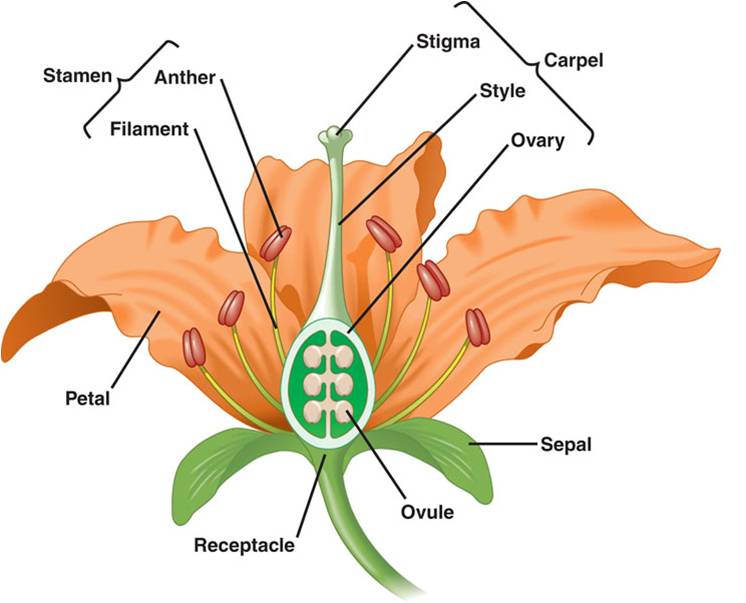 Flowers: A flower is a stem-like structure that bears whorls of leaf-like appendages.
The lowest whorl on this reproductive "twig" is the calyx, composed
of leaf-like sepals that form a protective shealth surrounding the flower bud.
The second whorl of leaf-like appendages is the corolla, containing the leaf-like
petals. The third whorl contains the stamens. Each stamen has a filament that
bears an anther at the end. The anther is where meiosis occurs and haploid microspores
develop into pollen grains. At the center of the flower is the pistil, or carpel.
This is the female portion of the flower, consisting of the stigma (a sticky
surface that receives pollen), the style (a stalk connecting the stigma to the
ovary) and the ovary. The ovary has compartments that contain the ovules. The
structure of flowers can vary tremendously, and may lack carpels, petals, pistils,
or stamens. The number of the parts may vary, also, and 'composite' flowers
may contain thousands of flowers growing together as one big inflorescence -
with some flowers only bearing petals, and other flowers only bearing stamens
or ovaries. A daisy is a good example of a composite - the petals are actually
the product of single 'ray' flowers that each ONLY bear one petal. The yellow
center of a daisy is composed of hundreds of individual 'disk' flowers that
don't have petals but do have stamens and pistils.
Flowers: A flower is a stem-like structure that bears whorls of leaf-like appendages.
The lowest whorl on this reproductive "twig" is the calyx, composed
of leaf-like sepals that form a protective shealth surrounding the flower bud.
The second whorl of leaf-like appendages is the corolla, containing the leaf-like
petals. The third whorl contains the stamens. Each stamen has a filament that
bears an anther at the end. The anther is where meiosis occurs and haploid microspores
develop into pollen grains. At the center of the flower is the pistil, or carpel.
This is the female portion of the flower, consisting of the stigma (a sticky
surface that receives pollen), the style (a stalk connecting the stigma to the
ovary) and the ovary. The ovary has compartments that contain the ovules. The
structure of flowers can vary tremendously, and may lack carpels, petals, pistils,
or stamens. The number of the parts may vary, also, and 'composite' flowers
may contain thousands of flowers growing together as one big inflorescence -
with some flowers only bearing petals, and other flowers only bearing stamens
or ovaries. A daisy is a good example of a composite - the petals are actually
the product of single 'ray' flowers that each ONLY bear one petal. The yellow
center of a daisy is composed of hundreds of individual 'disk' flowers that
don't have petals but do have stamens and pistils.
Flowers evolved to exploit animals for pollen transfer. Wind is capricious - the direction changes, the intensity changes, and even on a windy day only a small fraction of the pollen produced in a male cone will be lucky enough, just by chance, to travel to a female cone. For this reason, gymnosperms typically produce alot of pollen. By contrast, animals move through the environment non-randomly in search of food, shelter, and mates; and all animals can learn. So, by associating pollen with attractants (nectar, fragrance, and colorful floral displays) plants teach animals to visit flowers and increase the frequency of effective pollen transfer. Animals visiting an attractive flower are rewarded with food and quickly learn the association; they then travel in "bee-lines" from one flower to another seeking food, transfering pollen non-randomly and efficiently. This would be particularly useful for plants in the understory of a forest, where wind is minimal. The first angiosperms may have been shrubby, understory species. Animal pollination would also be very adaptive in tropical rainforests or deserts, where members of a single plant species may be very far away (decreasing the chances that a random procees like wind pollination would effectively find a 'mate').
As some angiosperms evolved into taller forms where wind could be used effectively, some were selected to use wind as a pollen-dispersal mechanism - with correlated reductions in flower size. So, wind-pollinated flowering trees (oaks, maples, etc.) and wind-pollinated field plants (open fields are windy environments, too) like grasses often have very small flowers with no colorful petals or sepals. Because they are not attracting animals for pollen dispersal, selection favors organisms that do not invest alot of energy in these structures.
Plants can increase the efficiency of pollen transfer even further by limiting flower visitation to one type of pollinator. A specialized pollinator that visits just one type of flower is more likely to transfer pollen between plants of the same species. Likewise, flowers visited by just one type of pollinator are likely to have nectar present when that pollintor visits. So, "pollination syndromes" have evolved, representing flower traits that are associated with a particular type of pollinator. For example, many flowers are red and tubelike. These flowers are often pollinated by hummingbirds, which see into the red end of the spectrum better than most insects and have a long beak that can access the nectar at the base of the flower. Butterfly flowers are often composites (like daisies, and zinnias), or are clustered in groups (butterfly bush). This allows the butterfly to land on a cluster and probe many individual flowers at a time with their long proboscis. Moth and bat pollinated flowers open at night. They are usually white and very fragrant, attracting their pollinators with scent. Some plants like skunk cabbage produce flowers that smell like rotting flesh. This attracts flies that act as pollinators. Some of the most elaborate contrivances by which plants limit pollination to a single species of pollinator are seen in the orchid family. Some orchids produce a scent that mimics the sexual pheromones of females of specific species of solitary wasps. When males perceive the scent, they fly up the concentration gradient to the flower. In some species, the flower also mimics the shape and coloration of the female wasp! The deception is so good that the male attempts to mate with the flower. It gets dusted with pollen, and flies off. While this may be frustrating for the wasp (who knows), it can't NOT fly down the next pheromone trail it encounters or it won't mate. So, if it flies down another trail and is tricked by another plant, pollen is transferred. The bucket orchid is another strange plant. Two petals have fused into a bucket that collect water. Pollinators fall in the bucket, and the only exit is through a tight squeezeway where they are dusted with pollen.
Fruits:Many angiosperms also evolved mechanisms to use animals to disperse their seeds. The ancestral condition within the group is probably the production of fleshy, ovary tissue that surrounds the carpels. Like nectar, this fleshy fruit tissue serves as a bribe, encouraging animals to eat the fruits and thereby disperse the seeds. And since animals tend to show a preference for a given habitat type, the seeds get transferred to another place with similar environmental conditions (rather than being strewn haphazardly across the environment by wind). Other fruits are dry - like acorns, grains, burrs, and some beans. If these are small, like in grasses, or have wings like maple samaras, or have feathery structures like milkweed, then the fruit can be dispersed by the wind. Some, like cocklebur, burdock, and goatshead, evolved hooks on their seed pods that could tangle in mammal fur. Some fruits are pea-pod like, and when the pod dries, the seam bursts open and the seeds are "shot out". This is called 'ballistic' dispersal. So, regardless of whether the fruit is animal or wind dispersed, plants have evolve many different ways to get their seeds dispersed and away from the competitive environment beneath the parent plant.
Diversity: The 300,000 angiosperm species have radiated into such a wide variety of shapes and behaviors that the evolutionary relationships among major groups (which each contain lots of diversity) is often difficult. However, several groups do fall out, especially with molecular analyses. Two ancient, basal groups are the Amborellales ( a small group of a few very primitive species) and the Nymphaeales (water lilies and their kin). Another ancient group is the Magnoliales, including the Magnolias and the laurels. Two other large and diverse groups are the monocots (including grasses, palms, lilies, and orchids), and the dicots (including 70% of all plants, from roses to oaks, from buttercups to maples). Monocots have one embryonic leaf (cotyledon), while dicots have two. Also, monocots have leaves with parallel veins, while dicots usually have leaves with a network of radiating veins. Monocots typically have flower parts in multiples of 3's, while dicots have flower parts in multiples of 4's or 5's.
6. Summary:
Over the course of plant evolution, organisms evolve characteristics that provided a selective advantage in progessively more desiccating environments, allowing plants to colonize new habitats unoccupied by other plants. The non-tracehophytes evolved a cuticle, and could colonize land and harvest more sunlight than their algal ancestors. Club mosses evolved vascular tissue and a dominant sporophyte, allowing them to grow tall and gain a competitive advantage over smaller non-tracheophytes. Ferns evolved more complex leaves, improving the transport of water and sugars into and out of leaves. The evolution of seeds, the reduction of the the gametophyte, and the elimination of swimming sperm allowed seed ferns and their descendants - the gymnosperms and the angiosperms - to colonize upland areas away from water. Conifers still dominate in the boreal forests of high latitudes; however, the angiosperms dominate in almost all other terrestrial habitats. Their innovations of flowers and fruits exploit animals in the environment, and improve the efficiency of pollen transport and seed dispersal. The evolution of plants is an interesting story of adapting to life on land, to take advantage of the abundant sunlight, oxygen, and mineral nutrients found in this habitat. The are an extraordinarily important, interesting, diverse, and beautiful group of living organisms.
Study Questions:
1. Known the timeline of major events in Earth history.
2. bacteria and archaea are more genetically diverse than eukaryotes. Why? And what does this diversity code for?
3. All eukaryotes are aerobic. List four types of metabolism that prokaryotes have with respect to oxygen.
4. Describe five ecological roles that prokaryotes play in the environment.
5. Describe the endosymbiotic theory of organelle origin, and provide evidence for this theory.
4. Why is bilateral symmetry, rather than radial symmetry, associated with "cephalization" in motile organisms?
5. Why are insects so diverse?
6. How did the jaw evolve and what benefit did it provide?
7. What were the probable benefits of colonizing land?
8. What is an amniotic egg and what benefit does it provide? Why did amniotes radiate in the Permian?
9. Describe the reproductive differences among the monotremes, marsupials, and placentals. What advantages were there for marsupial and then placental reproductive strategies?
10. Explain how a bird's respiratory system is more efficient than a mammal's.
11. What challenges face an aquatic algae as it tries to acquire light, gases, and nutrients?
12. To a photosynthetic organism, what are the benefits of colonizing land? What is the major "down side"?
13. Why are mosses short? Give two reasons.
14. In clubmosses, the sporophyte is tall but the gametophyte is small. Explain why in terms of the reproductive cells they produce.
15. Ferns and lycopods (clubmosses) dominated during the Carboniferous. Explain how their presence, and their fossilization, changed the atmospheric balance of CO2 and oxygen.
16. Draw the life cycle of a fern.
17. The two major innovations represented in the gymnosperms are seeds and pollen. Explain what each of these structures IS (in the contex of a plant life cycle), and explain how each structure allowed plants to colonize dry habitats.
18. How do showy flowers increase the efficiency of pollen transfer?
19. Describe three pollination syndromes.
20. Where doe the angiosperms that use wind dispersal live? Why have they evolved small flowers?
21. What is the adaptive advantage of fleshy fruit production?